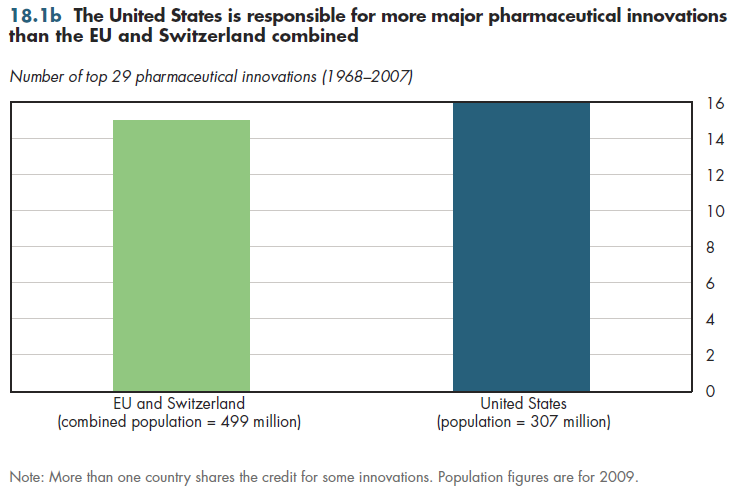Download PowerPoint versions of both figures.
Inside Collection (Book): American Health Economy Illustrated
18.1 US Leads the World in Medical Innovation
Summary: The United States leads the world in medical innovation.
The United States has contributed to more of the leading diagnostic and therapeutic innovations in medicine than has any other nation. Even combining the European Union (EU) and Switzerland, which collectively have approximately one-half billion residents, the United States outpaces this set of nations as a group by a considerable amount (figure 18.1a).

There is no one way to measure the nation's worldwide role in medical innovation. Figure 18.1a is based on a widely cited study of the most important medical diagnostic and therapeutic innovations developed between 1975 and 2000. These were systematically evaluated by leading primary care physicians and ranked by the effect of these innovations on patients. For some innovations, more than one country deserves credit. Even so, the United States was the country of origin for 20 of the top 27 such innovations. This is almost 50 percent more innovations than from the EU and Switzerland combined, even though these countries collectively have a population that is approximately 65 percent more than in the United States.
Researchers in the United States also were partially or solely responsible for nine of the top 10 such innovations. This again is much more than the contribution made by the EU and Switzerland collectively. Superiority in the United States can be measured in other ways. Of 99 recipients of the Nobel Prize in medicine and physiology since 1948, 60 were from the United States and 41 were from EU countries, Switzerland, Canada, Japan, and Australia. This group of countries collectively has a population more than twice that of the United States. Much of the funding for basic research in the United States comes from the National Institutes of Health (NIH), which spends approximately seven to 10 times as much as the countries in Europe spend. The 30 billion dollars in NIH funding excludes a similar amount spent by the private sector on some basic (but mostly applied) research. In the context of these enormous investments, the U.S. lead in innovation might not be that surprising.

The United States also is superior to the EU and Switzerland in terms of the top 29 pharmaceutical innovations developed in the 40 years starting in 1968 (figure 18.1b). This dominance in pharmaceutical innovation can be attributed to the sizable investments made by the pharmaceutical industry into R&D. The United States also dominates global funding for pharmaceutical R&D (figure 18.2a).
Downloads
References
- Whitman G and R Rand. Bending the Productivity Curve: Why America Leads the World in Medical Innovation. Cato Insitute. Policy Analysis No 654. November 18, 2009. http://www.cato.org/pubs/pas/pa654.pdf (accessed August 10, 2010).
Collection Navigation
- « Previous module in collection 17.4 Whether Social Burden of Illness Has Increased or Decreased Depends on How It was Measured
- Collection home: American Health Economy Illustrated
- Next module in collection » 18.2 US Accounts for More than Half of World Pharmaceutical R&D Spending
Content actions
Give feedback:
Download:
Add:
Reuse / Edit:
Twin Cities Campus:
- © 2012 Regents of the University of Minnesota. All rights reserved.
- The University of Minnesota is an equal opportunity educator and employer. Privacy
- Last modified on Sep 24, 2013 4:05 pm -0500









